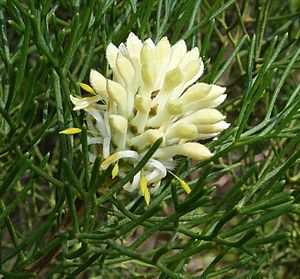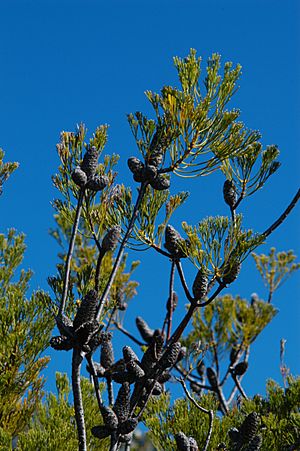Petrophile pulchella facts for kids
Quick facts for kids Conesticks |
|
|---|---|
 |
|
| Blackheath, Australia | |
| Scientific classification | |
| Genus: |
Petrophile
|
| Species: |
pulchella
|

The Petrophile pulchella, often called conesticks, is a common shrub found in eastern Australia. It belongs to the Proteaceae plant family. Its leaves are divided into soft, needle-like parts. The flowers are creamy-white and covered in silky hairs. They grow in oval-shaped clusters. After flowering, the plant produces fruit also arranged in oval heads. Conesticks usually grows in shallow, sandy soils. You can often find it in open forests or heathlands near the coast. Sometimes, it also grows in the nearby mountain ranges.
Contents
What Does Conesticks Look Like?
Petrophile pulchella is a shrub that can grow quite tall. In places where it's protected, it can reach about 1.5 to 3 meters (5 to 10 feet) high. But in windy, open heathlands, it might only grow to about 50 centimeters (20 inches) tall.
When the plant is young, its branches and leaves are soft and hairy. As it gets older, they become smooth. The leaves are usually 40 to 90 millimeters (1.6 to 3.5 inches) long. They have a stem (called a petiole) that is 30 to 50 millimeters (1.2 to 2 inches) long. Each leaf is divided two or three times into soft, needle-like sections. These sections are not sharp.
The flowers grow in oval-shaped heads. These heads are 20 to 35 millimeters (0.8 to 1.4 inches) long. They can be found where the leaves meet the stem or at the ends of the branches. Each flower is 6 to 10 millimeters (0.2 to 0.4 inches) long. They are cream-colored and have silky hairs. Conesticks usually flowers from August to March.
After flowering, the plant produces small nuts, about 3 to 4 millimeters (0.12 to 0.16 inches) long. These nuts are joined together in an oval head that can be up to 65 millimeters (2.6 inches) long.
How Conesticks Got Its Name
The conesticks plant was first officially described in 1796. Two botanists, Heinrich Schrader and Johann Christoph Wendland, gave it the name Protea pulchella. They found the original plant near Botany Bay in Australia.
Later, in 1810, a famous botanist named Robert Brown changed its name. He moved it to a new group of plants called Petrophile. So, its full scientific name became P. pulchella. The word pulchella comes from Latin and means "beautiful."
Where Conesticks Grows
Petrophile pulchella can be found in south-eastern Queensland. It also grows south along the coast and nearby tablelands in New South Wales, reaching as far as Jervis Bay.
It often grows alongside other native Australian trees. These include Sydney peppermint (Eucalyptus piperita) and smooth-barked apple (Angophora costata). You might also see it in more open woodlands with trees like scribbly gum (Eucalyptus sclerophylla) or silvertop ash (E. sieberi).
Conesticks also shares its home with other shrubs. Some of these are mountain devil (Lambertia formosa), broad-leaved drumsticks (Isopogon anemonifolius), and paperbark tea-tree (Leptospermum trinervium).
Conesticks and Fire: How it Survives
Conesticks plants are killed by bushfires. However, they have a clever way to survive. After a fire, new plants grow from seeds that were stored in the plant's cones (fruit heads). This is called a "seedbank."
These plants can live for up to 60 years in the wild. Studies have shown that conesticks plants produce more seeds in areas that have had fires more often, especially if the fires were less than seven years apart. This means that regular fires can actually help the plant reproduce more successfully.
The seeds can stay alive and sprout up to 700 days after a bushfire. It's even possible that the seeds could last for up to 90 years in the soil, waiting for the right conditions to grow. Native bees are thought to help pollinate this plant, helping it to make new seeds.

